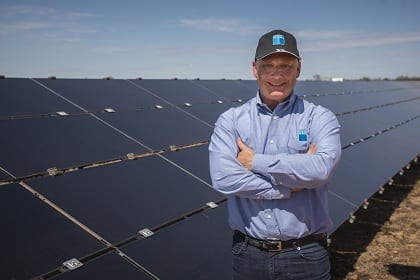AGL Energy has suggested it could install more “virtual power plants” across Australia, tapping into the solar and battery storage resources of its household and business customers to meet peak demand needs and provide network services.

AGL, in partnership with its partially owned storage and software specialist Sunverge, last week unveiled plans for a 7MWh virtual power plant in Adelaide, tapping into 1,000 individual battery storage devices installed in solar-powered homes and businesses with the help of funding from the Australian Renewable Energy Agency.
AGL chief executive Andrew Vesey says that the VPP – which he dubs the world’s largest – will act as a “solar peaking plant”, meaning that it will be able to use solar resources to respond to sudden changes in demand, including the expensive demand peaks. Such peaks have usually been served only by expensive gas and diesel generation.
Vesey says more solar and battery storage based VPPs could follow. “This concept has considerable potential throughout AGL’s network as battery technology develops and becomes increasingly affordable,” he told an analysts briefing following the release of the company’s annual results on Wednesday. (See David Leitch’s analysis of AGL results here).
VPPs, Vesey notes, have the potential to become a more efficient means of dealing with costly peak demand, but can also provide network benefits by supporting more renewable energy, and lead to lower bills for consumers. (See Sophie Vorrath’s feature on the Adelaide virtual power plant proposal here).
Vesey sees such projects as a key element in the transformation of AGL Energy’s business, even if the pace of that transformation is uncertain, and frustrating for environmental groups such as 350.org, which on Wednesday described its sustainability report – where AGL flags that its coal generators will continue operating for several more decades – as “greenwash.”
But AGL’s result, and Vesey’s comments, highlight the complexities of that transition – notably, how AGL can go full, or even half-steam into new technologies and business models while protecting its incumbent assets, and how it deals with competition from elsewhere, most notably the networks who are also experimenting with virtual power plants and battery storage.
A big part of that is the rules and regulations that govern the industry. Critics say they are shaped by the needs of 20th century technology that is fast becoming redundant. But there is huge debate about how the necessary changes would be framed.
AGL repeated on Wednesday its desire for wholesale changes to the National Electricity Market so it can incorporate high penetration of renewables. That sounds admirable until you read the fine print of what AGL proposes – essentially a shift to “capacity” markets that have been widely criticised elsewhere.
And while AGL and others are pushing for incentives like “capacity markets” to ensure gas-fired generators are not mothballed, they are also seeking “incentives” for the “orderly replacement of capital stock,” which effectively means the closure of some of Australia’s excess supply of coal-fired generation.
The third element of AGL’s reform plan is changes to the regulations to facilitate development of distributed energy, such as VPPs; but its focus here is on “ring-fencing” network business subsidiaries to try to limit competition from the networks, who may find battery storage will reduce the need for poles and wires and may also see value in having the technology installed across its network, including in homes and businesses, as some are already trialing.
At the same time as proposing these changes, AGL has also been fighting proposals to change the “settlement” period on the wholesale electricity market from 30 minutes to 5 minutes.
Proponents say the 30-minute rule favours old and slow responding gas plants, while moving the settlement period to 5 minutes will favour battery storage and other smart software technologies. Their position is supported by both the market regulator and operator. It’s a classic illustration of how rules can favour one technology over another.
Vesey was asked about this position by an analyst on Wednesday, to which he responded: “We are not supportive of that kind of rule change … we want broader structural changes that need to be done across the NEM.”
Which basically tells us this: Turning this ship around is going to be a complicated business. AGL’s recently acquired coal portfolio – it is now the biggest coal generator in the country – is delivering record profits (before write downs of gas assets and smelter supply contracts) thanks to the rise in wholesale electricity prices.
This, of course, begs the question: Can a company like AGL both protect its incumbent assets and make the push into new business models as quickly as the technology emerges and as the climate science demands?
Even Vesey is not sure of that. On Wednesday, he announced the appointment of a new head of new energy, Elisabeth Brinton, a senior utility executive from the US who has led start-ups, and has pushed for high renewable targets in California.
Brinton will be responsible for that push into solar, battery storage, electric vehicles and charging stations and the creation of virtual power plants, and will presumably help drive a cultural shift within AGL – something which needs to be in progress right across the industry.
At the moment, that business has revenues of just over $100 million and is making a pre-tax loss of $21 million. It is little more than a couple of lines in a multi-billion dollar business. Just how quickly that division can grow, and is allowed to grow, is going to be fascinating.










